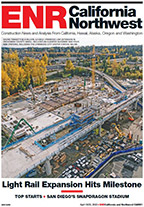Thanks to a state directive mandating the use of more renewable energy and a new federal priority on advancing renewable projects on public lands, solar power claimed the first five spots on this year's ENR California Top Starts ranking for projects that broke ground in 2011.
Those five solar projects totaled $7.9 billion, a 52% jump over the combined value of the top five on last year's list (ENR California 4/11/11), which was dominated by high-profile transportation projects funded by the American Recovery and Reinvestment Act.
This year's roster excludes a massive solar project that broke ground in January 2011 before being put on hold soon thereafter. The developer of the $4-billion, 1,000-megawatt Blythe solar power project in Riverside County, Solar Millennium AG, Erlangen, Germany, originally planned it to be a thermal powerplant using parabolic troughs. But after the project broke ground, the company decided to switch to photovoltaic technology because of a steep drop in solar panel prices. Solar Millennium later declared insolvency. The Blythe project is expected to restart sometime next year after new owners are found.
Three factors are propelling the California solar push. First, and most obvious, California has abundant sunshine, especially in the deserts of the state's southern region. That helps give solar tremendous promise as a reliable energy source into the future.
Second, Gov. Jerry Brown (D) last April approved a renewable-energy mandate that requires that 33% of electricity in California must come from renewable sources by 2020.
Third, the Interior Dept.'s Bureau of Land Management, backed by the Dept. of Energy, has identified 16 solar energy zones nationwide for development. Two are in California. The projects must adhere to a host of environmental regulations, but BLM has fast-tracked the approval process. The federal government is granting use of public land for energy projects partly because it would reap millions of dollars in annual rent from solar project owners. The two California projects on federal land are the Desert Sunlight solar farm and the Genesis solar energy project, both in Riverside County.
Solar projects in the state also are gearing up to take advantage of federal tax credits that expire in 2016, says Cara Libby, project manager/renewable generation at the Electric Power Research Institute, Palo Alto.
Libby also notes that declining panel prices are giving developers fits. "The current glut of product is not sustainable, but it will take over a year before things settle out," she says.
A key player in California's solar power expansion is First Solar, Tempe, Ariz., which has been instrumental in three of the list's top five projects. The company, founded in 1999, makes thin-film solar modules and has manufacturing plants in Perrysburg, Ohio; Frankfurt, Germany; and Kulim, Malaysia. First Solar says its panels—made from cadmium telluride, not silicon—are the lowest-priced in the market.
The company covers all the bases, including project development, financing, engineering, procurement, construction and operations and maintenance for a PV project's life.






